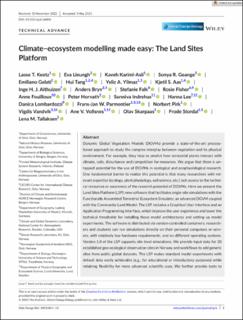Climate–ecosystem modelling made easy: The Land Sites Platform
Keetz, Lasse Torben; Lieungh, Eva; Karimi-Asli, Kaveh; Geange, Sonya Rita; Gelati, Emiliano; Tang, Hui; Yilmaz, Yeliz A.; Aas, Kjetil Schanke; Althuizen, Inge; Bryn, Anders; Falk, Stefanie; Fisher, Rosie; Fouilloux, Anne; Horvath, Peter; Indrehus, Sunniva; Lee, Hanna; Lombardozzi, Danica; Parmentier, Frans-Jan W.; Pirk, Norbert; Vandvik, Vigdis; Vollsnes, Ane Victoria; Skarpaas, Olav; Stordal, Frode; Tallaksen, Lena M.
Journal article, Peer reviewed
Published version

Åpne
Permanent lenke
https://hdl.handle.net/11250/3075459Utgivelsesdato
2023Metadata
Vis full innførselSamlinger
- Department of Biological Sciences [2221]
- Registrations from Cristin [9580]
Sammendrag
Dynamic Global Vegetation Models (DGVMs) provide a state-of-the-art process-based approach to study the complex interplay between vegetation and its physical environment. For example, they help to predict how terrestrial plants interact with climate, soils, disturbance and competition for resources. We argue that there is untapped potential for the use of DGVMs in ecological and ecophysiological research. One fundamental barrier to realize this potential is that many researchers with relevant expertize (ecology, plant physiology, soil science, etc.) lack access to the technical resources or awareness of the research potential of DGVMs. Here we present the Land Sites Platform (LSP): new software that facilitates single-site simulations with the Functionally Assembled Terrestrial Ecosystem Simulator, an advanced DGVM coupled with the Community Land Model. The LSP includes a Graphical User Interface and an Application Programming Interface, which improve the user experience and lower the technical thresholds for installing these model architectures and setting up model experiments. The software is distributed via version-controlled containers; researchers and students can run simulations directly on their personal computers or servers, with relatively low hardware requirements, and on different operating systems. Version 1.0 of the LSP supports site-level simulations. We provide input data for 20 established geo-ecological observation sites in Norway and workflows to add generic sites from public global datasets. The LSP makes standard model experiments with default data easily achievable (e.g., for educational or introductory purposes) while retaining flexibility for more advanced scientific uses. We further provide tools to visualize the model input and output, including simple examples to relate predictions to local observations. The LSP improves access to land surface and DGVM modelling as a building block of community cyberinfrastructure that may inspire new avenues for mechanistic ecosystem research across disciplines.
